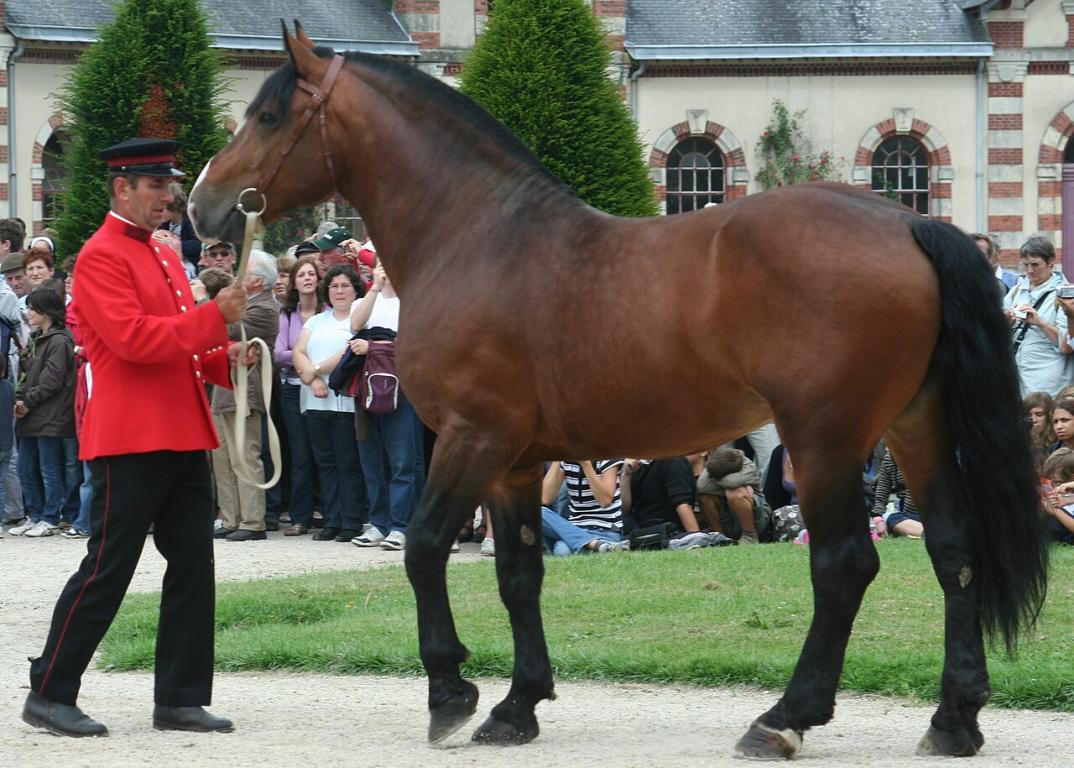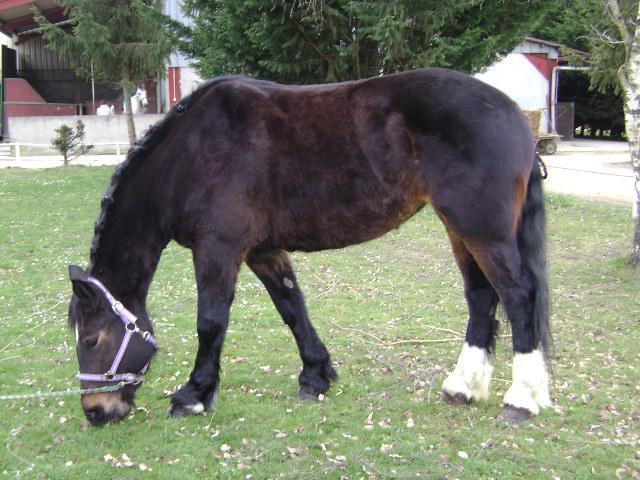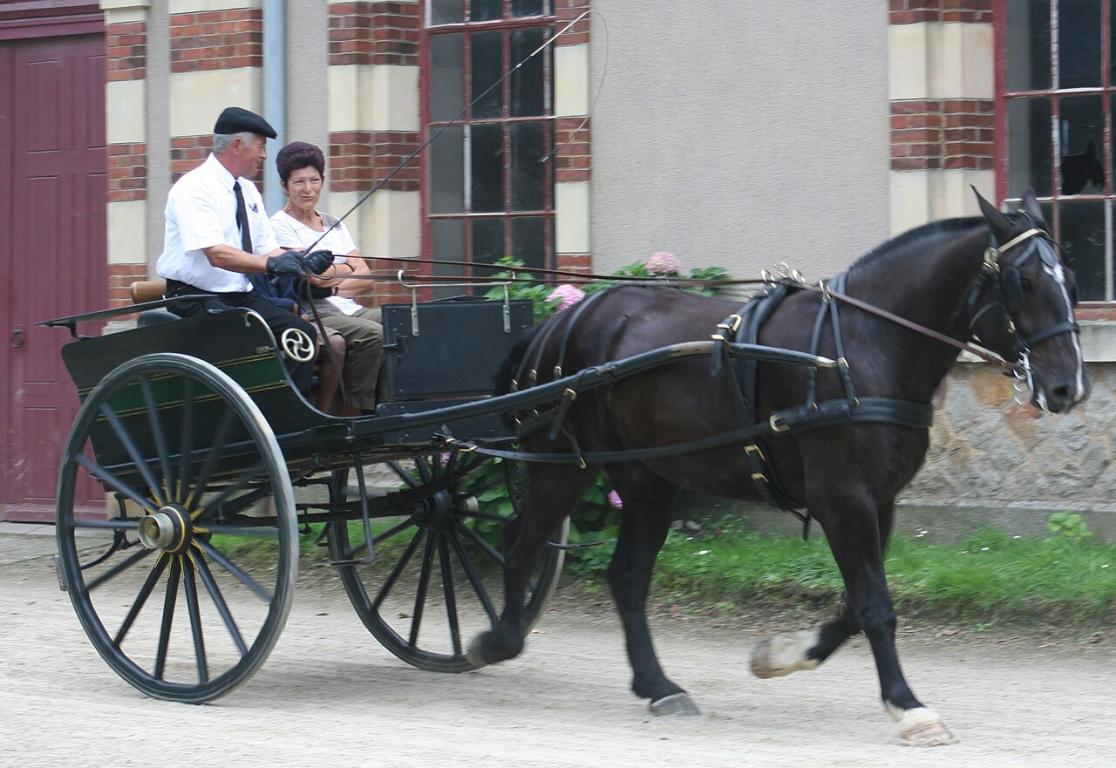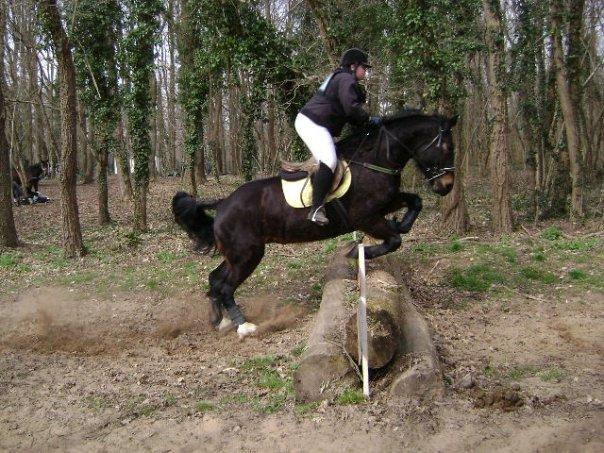
Continent: Europe
Country: France
Weight: 550 – 900 kg
Height: 155 – 165 cm






The Cob Normand originates from Normandy, a region in northwestern France known for its fertile farmland, lush pastures, and temperate climate, all favorable to horse breeding. More precisely, the breed's cradle lies within the departments of Manche, Calvados, Orne, and Eure.
Culturally, the Cob Normand is the heir to a long tradition of horse breeding in Normandy, a land renowned for its horses since the Middle Ages.
The breed was developed through crossbreeding between local mares (often of carriage or post-horse type) and imported stallions particularly English breeds such as the Norfolk Trotter and the Hackney in the 19th century. It was selectively bred to meet the needs of a powerful, enduring, and elegant working horse, suitable for agriculture, transport, and artillery.
Today, the Cob Normand is an integral part of Normandy’s rural heritage, a symbol of ancestral farming expertise and of the close bond between humans and draft horses in this region.
The main breeding area of the Cob Normand is located in Normandy, more precisely in the following departments:
- Manche
- Calvados
- Orne
- Eure
- Seine-Maritime
These territories represent the breed’s historic cradle, with rich natural pastures, a humid temperate climate, and a long-standing equestrian tradition that fosters extensive horse breeding.
Some additional breeders can be found outside Normandy, notably in:
- Hauts-de-France
- Centre-Val de Loire
- Occasionally in Nouvelle-Aquitaine or eastern Brittany, especially among driving enthusiasts or within animal traction and sustainable farming initiatives.
Despite this slight dispersion, the breed’s geographic distribution remains strongly centered in Normandy, making it a regionally rooted breed with a strong cultural identity.
The Cob Normand plays a significant role in the genetic heritage of both draft and light horse breeds in France.
Its genetic value is based on several key aspects:
- Foundational breed in crossbreeding: Historically, the Cob Normand has been used to improve other breeds thanks to its robustness, docility, and energetic gaits.
It notably contributed to the creation of the Selle Français, by crossing Cob mares with hot-blooded stallions (Thoroughbreds, Anglo-Arabs).
- Preserved genetic diversity: Although the population is small, the Cob Normand stud-book maintains valuable genetic variability within French draft breeds.
Selection efforts aim to avoid inbreeding and to preserve a stable gene pool.
- Adaptation to modern driving: Thanks to its flexibility, balance, and liveliness, the Cob Normand is an excellent driving horse.
It contributes to the development of modern horse-drawn work, in leisure, tourism, and even public services (such as horse-drawn waste collection or urban logging).
- Symbol of sustainable regional breeding: It embodies the resilience of local breeds in the face of standardized livestock farming.
Its conservation supports the functional and cultural diversity of European horses.
In summary, the Cob Normand represents a strategic genetic resource for crossbreeding programs, modern traction, and the preservation of rustic, multipurpose equines.
The history of the Cob Normand is rooted in a long-standing tradition of horse breeding in Normandy, a region renowned since the Middle Ages for the quality of its horses.
The breed primarily descends from the Norman Carriage Horse, a robust animal used in the 19th century to pull stagecoaches and fast carriages.
19th Century: Foundation of the Type :
At the beginning of the 19th century, Norman breeders began crossing local mares with foreign stallions, especially:
- Norfolk Trotters
- Hackneys
- Thoroughbreds
These crossbreeds aimed to improve gaits, vitality, and conformation. They produced a more elegant, faster, and stronger horse, well-suited for driving and transport.
Early 20th Century: Official Recognition :
In 1912, the Cob Normand stud-book was officially established.
The breed became sought after for:
- light farm work
- military artillery
- horse-drawn transport
20th Century: Decline with Mechanization :
Starting in the 1950s, the mechanization of agriculture led to a significant decline in demand.
Some Cob Normands were used in crossbreeding, either for meat production or to enhance the Selle Français breed.
Contemporary Revival :
In the 1990s and 2000s, the breed experienced a revival, driven by growing interest in:
- recreational and competitive driving
- eco-friendly animal traction
- rural heritage preservation
Breeders, in collaboration with the IFCE, are working to preserve the genetic diversity of the breed and to promote its modern-day utility.
From war and mail carriage horse to a symbol of modern ecological and leisure use, the Cob Normand embodies the resilience of a local breed capable of adapting to social and agricultural changes while staying true to its identity.
The Cob Normand is widely recognized for its balanced temperament and reliability, making it a favorite among both professionals and amateurs.
- Docile: Easy to handle, it learns quickly and responds calmly to human interaction.
- Willing and straightforward: Shows eagerness to work, whether in harness or under saddle.
- Patient and calm: Suitable for beginners and bustling environments (markets, urban areas, tourist carriages).
- Sociable: Generally gets along well with other horses and is comfortable around humans.
- Enduring and steady: Works with consistency, without agitation or loss of motivation.
Mental Aptitude :
Combining calmness with energy, the Cob Normand is an excellent driving horse, able to maintain a steady pace while staying focused.
It adapts well to new or unfamiliar situations, making it ideal for urban, educational, or tourism activities.
The Cob Normand is a trustworthy, calm, and hard-working horse, appreciated for its practical intelligence, emotional stability, and great adaptability. It is a reliable partner, whether for demanding tasks or family leisure.
The Cob Normand faces mixed, but overall encouraging prospects, thanks to growing efforts to promote local breeds and the sustainable use of horses.
Challenges :
The breed remains numerically fragile, with a declining population since the mechanization of agriculture in the 20th century.
Its original role as a farm workhorse is no longer a major market.
Competition with sport breeds and limited visibility in the leisure horse market sometimes hinders its development.
Strengths :
The Cob Normand enjoys increasing recognition in recreational and competitive driving, thanks to its energetic gaits, balance, and calm temperament.
Its adaptability to modern uses such as equine tourism, animal traction, or logging attracts professionals looking for eco-friendly solutions.
It is also valued in educational, social, and inclusion programs through horse-drawn activities.
Ongoing efforts :
Dedicated promotion programs and driving competitions are helping increase awareness.
The diversification of outlets is supported by the IFCE, Haras Nationaux, and breeder associations.
The Cob Normand is listed as a "Rare Breed", which qualifies it for specific conservation subsidies.
Outlook :
- Repositioning as a modern, sustainable, and versatile utility horse
- Maintaining genetic diversity through careful stud-book management
- International development, especially in regions interested in animal traction or driving
If efforts to promote and adapt the breed to new uses continue, the Cob Normand is well-positioned to sustain its place in the French equine landscape, as a rustic, reliable horse carrying a strong tradition.
The Cob Normand is a breed known for its natural hardiness, longevity, and resistance to disease, making it a rustic horse well-suited to a variety of living conditions, including outdoor life.
Strengths :
- Excellent hardiness: Easily adapts to pasture life, even in wet or cold climates such as Normandy.
- Low incidence of genetic diseases: The rigorous stud-book management and preserved genetic diversity have limited hereditary defects.
- Good longevity: With proper care, Cob Normands often remain active beyond the age of 20.
- Strong limbs and hooves: Generally correct conformation with tough hooves, often requiring no permanent shoeing.
Potential Considerations :
- Weight gain: Like many draft breeds, Cob Normands can gain weight easily if their diet is not suited to their activity level.
- Joint stress: In cases of overwork or excessive load (especially in intensive driving), monitoring joint health is recommended.
- Parasites: As with any horse living on pasture, regular internal and external parasite control is necessary.
The Cob Normand is a healthy, strong, and durable horse with no major specific health concerns.
A balanced diet, basic routine care, and regular physical activity are enough to keep this breed in optimal health.
A four-beat gait, where each hoof touches the ground one after the other in a regular sequence. It is a calm and symmetrical gait, commonly used to assess the horse’s temperament and submission.
The Cob Normand typically displays good forwardness, ample stride, and engaged hindquarters at the walk.
A two-beat diagonal gait (left front with right hind, then right front with left hind), marked by a short suspension phase. It is a springy and rhythmic gait.
For the Cob Normand, the ideal trot is energetic and brilliant, with impulsion, balance, and freedom of movement but without excessive heaviness.
A three-beat asymmetrical gait, with a moment of suspension. Although natural, the canter is rarely judged in conformation shows for draft breeds.
In the Cob Normand, the canter is appreciated especially in ridden or driven tests, to assess suppleness, balance, and rhythm.
Born on 01/01/2004
Winner of numerous conformation and movement competitions.
Used as a breeding stallion for his fluid gaits, strong back, and gentle temperament.
Represents the ideal type sought after in the breed: a perfect balance between strength, elegance, and spirit.